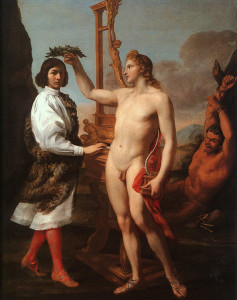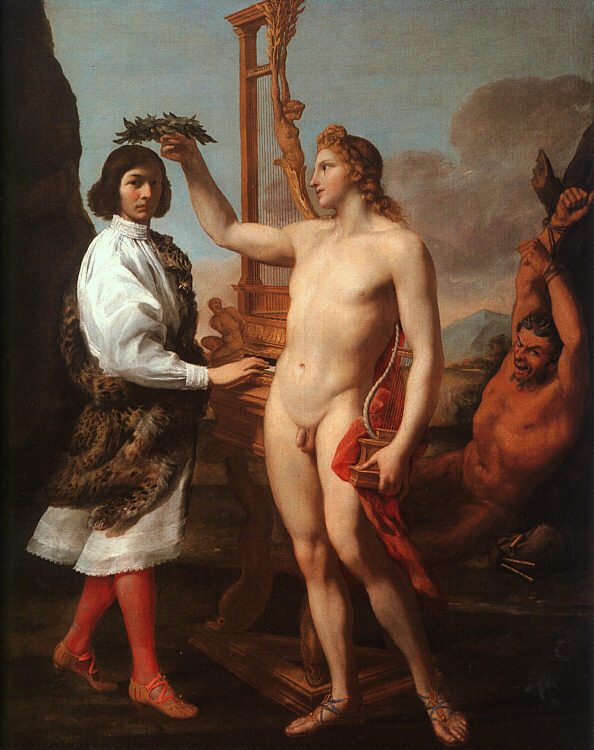
by Andrea Sacchi
The following comes from Andrew Lear, an art historian and founder of Oscar Wilde Tours, which will be offering gay tours of New York, including the Met, starting this spring, as well as a gay history tour of Italy next October. For more information, visit www.OscarWildeTours.com.
AS AN ART HISTORIAN who works on homoerotica, sometimes I meander around museums, looking for homoerotic works that scholarship has overlooked. I usually spend most of my time in the ancient Greek and Roman galleries, since that is my specialty. But sometimes I wander off. l look for male-male couplings in Indian temple carvings or pictures of actor-prostitutes in 17th-century Japanese teahouses. One of the best places to hunt is the Renaissance galleries, where artists like Donatello and Michelangelo made versions of Classical nudes that expressed their homosexual desires—and their vision of homosexual attractiveness.
Recently I’ve been exploring New York’s Metropolitan Museum of Art, partly because I want to give some tours of it in the spring, but also because it’s such a big treasure house of art—and of homoerotica. And of course I have found some fun things.
This is one of my favorites finds: Andrea Sacchi’s Marcantonio Pasqualini Crowned by Apollo, in which the god Apollo crowns a famous castrato, Marcantonio Pasqualini, the top male soprano of Rome in the mid-17th century. I particularly like this painting because it set off my “art gaydar” before I knew the story behind it—and it turned out I was right. It’s a complicated painting with a lot of meanings. Among other things, it is a memorial to a homosexual relationship between Pasqualini and Cardinal Antonio Barberini, nephew of Pope Urban VIII and, like his uncle, a great patron of the arts. Yes, a love affair between a castrato singer and a Cardinal, memorialized in an elaborate painting: it sounds like something out of an Anne Rice novel, but here it is in the flesh.
I suppose the first thing that caught my eye was the nude Apollo; not only is he nude, but his genitalia are right in the center of the painting, which is pretty unusual. He’s also a perfect example of the Renaissance idea of a male sex object. He’s like a Classical nude; in fact, he’s a pretty close copy of the Apollo Belvedere in the Vatican. But while the ancient sculpture is rather hard-lined and somehow seems domineering, here the artist has softened his lines: he’s muscular but tender, and he has the face of an intersex angel. This is typical. Unlike the ancient Greeks, the Renaissance saw adolescent males as attractive because they were somewhat feminine—hence their taste for castrati—so they tended to feminize their ancient prototypes.
But the main things that struck me as I looked at the painting were that it was obviously very complex and that it somehow felt very gay to me. The complexity stems from the variety of elements, and the complicated relationships among them. First, there’s the contrast between Apollo and Pasqualini: Apollo is naked, Pasqualini very dressed up; and the painting seems to go out of its way to emphasize the fact that Apollo has balls, while, of course, Pasqualini did not. Then, to the right, there’s a weird figure who’s tied up. This is the satyr Marsyas, who challenged Apollo to a musical contest and who was flayed alive by the victorious Apollo. There’s an obvious contrast between Marsyas and Pasqualini: Marsyas is nude and has red skin and a wild, angry expression, while Pasqualini has elaborate clothes, a peach complexion, and perfect composure. There’s also a contrast between their three instruments: Pasqualini is playing a sort of a clavichord that’s also an upright lyre—Apollo’s instrument—decorated with a figure of a girl turning into a tree, i.e. Daphne, who turned into a laurel tree to avoid being raped by Apollo. Marsyas has a zampogna, a kind of rustic Italian bagpipe.
So, what does this all mean? Well, I’ve read a lot about this painting in recent weeks, and it seems it is probably a complicated allegory about styles of art. Pasqualini represents art that is classy and obedient to tradition, while Marsyas represents wild folk art. Some scholars have suggested that Marsyas represents the followers of Caravaggio, and he does remind me of Caravaggio—who, by the way, also has a homoerotic canvas at the Met! I’m frankly not sure of the meaning of the body parts theme, but it is something like the following: Pasqualini gave up his testicles out of obedience to God, while Marsyas is going to lose his skin out of disobedience. True, it’s a little weird, but keep in mind that Italians in the 17th century were very enthusiastic about castrato singers and defensive about how they got that way: “Evviva il coltello!” (“Long live the knife!”), they would shout as they applauded at the opera.
What I am sure of is that there’s a further, gay meaning. As it turns out, it was Pasqualini’s lover, Cardinal Barberini, who commissioned the painting. He was the patron of Pasqualini and also of Sacchi, the painter, both of whom lived in his palace. So, in some sense Apollo, the god of the arts, who is crowning Pasqualini, must represent Barberini, his actual patron. This must be why the Cardinal had the painting done: to commemorate his artistic patronage and brag about his relationship with a famous (castrated) sex symbol.
This is not the kind of gay relationship people have today (I hope!), but it is a very cool artifact from the gay past. And that is exactly the kind of thing I’m looking for when I meander around a museum.
Andrew Lear, PhD, is a classical historian who has taught art history and Classics at Harvard, Columbia, and NYU. He is the founder of Oscar Wilde Tours (www.OscarWildeTours.com).







Discussion7 Comments
Such an intriguing story behind such an intriguing painting, Andrew Lear
should be writing one hell of an art history book one day.
The fact that Apollo’s cock and balls are at the center of this painting is a “see-able” revelation that you can’t quite wrap your senses around.
Thanks, Raymond! If you’re interested, check out my book on male-male courtship in Greek vase-painting (Images of Ancient Greek Pederasty: Boys Were Their Gods, Routledge 2008). I promise it’s more fun than most academic books….
Will do, can’t wait.
I am currently reading “The Persian Boy” by Mary Renault, which is another revelation.
The fact that a enunch who is trained to service men could become such an important person to Alexander The Great is such a mind-blowing read.
I will try to get your book at Barnes and Noble.com.
Dear readers! A couple of people have asked me where to get more information about my New York and Metropolitan Museum tours. They should be available on the Oscar Wilde Tours website by next week (hopefully Wednesday 12/17). Please come try us out!
I love Mary Renault! Read “The Last of the Wine” if you have a chance: it gives a quite accurate portrayal of elite, idealized ancient Greek pederasty — what we should really call “Platonic love.”
Will do, and, according to Mary Renault,in “The Persian Boy”, Alexander the Great could not have gotten through the last years of his life without the love of a boy, Bagoas. And this love does thrive on both a committed devotion and sexual gratification.
Pingback: Gay Art History Tours Homoerotically Rethink the Metropolitan Museum's Artwork - artnet News